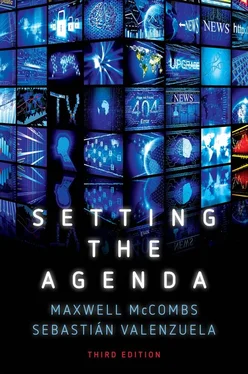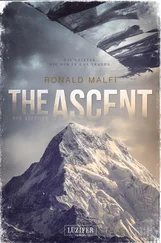An extensive longitudinal analysis of the agenda-setting effects of the New York Times’ coverage on the public’s responses to the Gallup Poll’s ‘most important problem facing the country’ from 1956 to 2004 found variations in the strength of these effects, but no discernible trend over time. 53This finding was replicated in a more recent time-series analysis based on media content and public opinion data collected in Sweden between 1992 and 2014. In it, the authors analysed both aggregate and individual-level agenda-setting effects on public opinion concerning twelve different political issues. Their results show that the traditional news media were as influential as an agenda setter in 2014 – an era of high-choice media – as in 1992 – an era of low choice. 54Similarly, a longitudinal analysis 55of broadcast television’s agenda-setting power conducted in Chile between 2001 and 2016 found that the correlation between media and public agendas averaged +0.75. Furthermore, there was no downward linear trend – if in 2001 the correlation hovered at +0.90, by 2016 it was still at a strong +0.80.
Another way of tracking variation in agenda-setting effects due to the proliferation of digital channels is through cohort analysis, in which different generations of individuals are compared in their susceptibility to the media agenda. Although media-use patterns among different generations do diverge in the new communication environment, state-wide surveys in North Carolina and Louisiana found little difference in agenda-setting effects among the younger, middle, and older generations. 56Greater attention to the internet and much less attention to traditional media among young adults had little impact on the magnitude of agenda-setting effects. Particularly compelling is the comparison in Louisiana of the issue agendas of low and high internet users to the issue agenda of the state’s major newspapers. For low internet users the correlation with the newspaper agenda is +0.90. For high internet users, the correlation is +0.70.
Likewise, comparisons between the issue agendas of the New York Times and the younger, middle, and older generations across the election years in the US from 1976 to 2004 found no inflection points associated with these events in the long-term trends. 57The overall pattern is one of strong agenda-setting effects across the years and no large differences among the generations despite variations in their media-use patterns. For the younger generation, the median correlation is +0.77 across these decades with a range of +0.55 to +0.93. For the 35 to 54-year-olds, the median is +0.79 with a range of +0.66 to +0.93. Among those 55-and-older, the median value is +0.77 with a range of +0.61 to +0.93.
Furthermore, the meta-analysis discussed earlier 58showed that year of publication of the study was not a significant predictor of the strength of the agenda-setting effect, which suggests that the influence of traditional news media – which are the most studied media in the articles used in the meta-analysis – remains as strong as it used to be.
Both the strength of agenda-setting effects in past decades and their continuing strength in contemporary settings result from long-standing patterns of behaviour in the media and among the public. The high degree of homogeneity among media agendas found in the original Chapel Hill investigation continues in contemporary settings. Pablo Boczkowski not only found a high level of homogeneity among the news agendas of the major print and online newspapers in Buenos Aires, but also noted the increasing similarity of these news agendas from 1995 to 2005, a trend that he attributes to the facilitation of journalists’ long-standing habit of monitoring the competition by the plethora of news now available on the internet and television. 59Among the public, strong agenda-setting effects result from civic osmosis, the continuous exposure to a vast sea of information from many channels of communication. 60Applying network analysis to Nielsen data on TV and internet use from March 2009 collected from over 1,000 homes, James Webster and Thomas Ksiazek noted:
We find extremely high levels of audience duplication across 236 media outlets, suggesting overlapping patterns of public attention rather than isolated groups of audience loyalists. 61
For most people, this exposure ranges from habitual and deliberate attention to some news channels to incidental exposure to other news channels in the course of daily life. In tandem with the homogeneity of these news channels, the outcome is a high degree of consensus among the public about the major issues of the day.
3. To what extent are there specific channel effects vs. the collective impact of a communication gestalt?
Long-standing interest in the effects of media has frequently been accompanied by a fascination with the relative power of the various communication channels to achieve those effects. Agenda setting has been no exception. Once people understand the basic idea of agenda setting, they are quick to ask which medium is more powerful in setting the public agenda. In the latter half of the twentieth century, attention was directed particularly at comparisons between newspapers and television. Now the panoply of social media has been added. The best answer to this question is: ‘It depends.’ Whether all these channels speak as a chorus, with little difference among them, or whether one or two channels clearly surpass the others in impact, varies considerably from one situation to another. Even where differences do exist, most of the channels contribute to these agenda-setting effects. We swim in a vast sea of news and information, a gestalt of communication channels, where the whole is far greater than the sum of its parts.
However, in the examination of media effects over the years, there has been a tendency to emphasize individual media more than the media collectively. This is particularly salient in the literature on media effects and political polarization, a body of work that has been studied in the agenda-setting literature under the rubric of ‘attribute agenda setting’. For instance, a study conducted in the context of the US elections of 2012 found that the affective attributes (e.g. morality, leadership, caring, intelligence, and honesty) of the candidates emphasized by a partisan channel (Fox News) produced a different agenda-setting process when compared to more neutral networks (CNN and NBC). 62This line of research confirms that people are influenced by the media they choose to use, such that polarization and the ensuing audience fragmentation does not weaken the existence of individual-level media effects.
In contrast, the concept of civic osmosis emphasizes this collective role of the media. And the proliferation of new media adds a rich variety of dynamic channels to this communication gestalt. Increasingly, we swim in a sea of diversity, and we need to understand the currents in this sea, both those that enhance communication and those that pollute the sea. Above all, we need to understand the sea as a whole, how it changes and shifts over time, and how it impacts the public agenda. There is abundant empirical evidence about the absorption of news and information from this communication gestalt that dates from the earliest days of our field to the present. In the benchmark 1940 Erie County study, Paul Lazarsfeld and his colleagues found substantial overlap in people’s use of the various mass media:
People highly exposed to one medium of communication also tend to be highly exposed to other media. There are relatively few who are highly exposed to one medium and little exposed to the other. 63
Although, in response to survey questions, people can name a particular news medium as their primary source – the newspaper that they read most mornings, the radio or TV news that they tune to with some regularity – people are far from immune to the larger news environment. In the 1996 Spanish national election, there was considerable similarity between people’s level of agreement with their primary medium’s agenda in comparison to their level of agreement with the agenda of the primary medium’s principal competitor. 64For example, among voters who identified Diario de Navarra as their primary news source, the agenda-setting correlation was +0.62. Their level of agreement with the competing local newspaper was +0.57. Across eighteen comparisons, the median difference in the correlations is only 0.09.
Читать дальше












